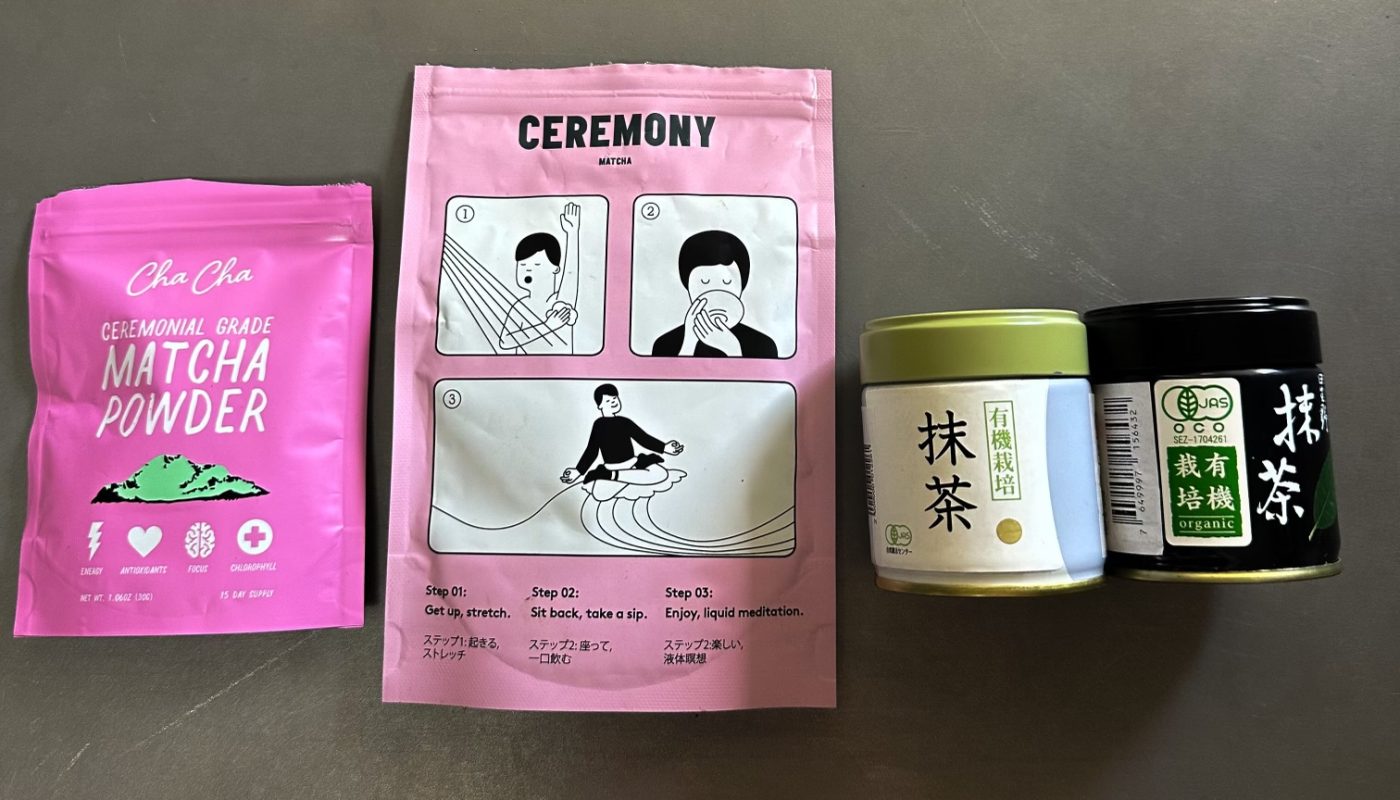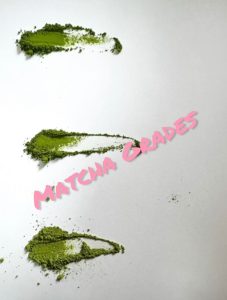Not all Matcha is alike. There are, in fact, different Matcha grades available. Knowing each grade and their properties allows you to make the best-informed decision about which one is right for you. To help you to select the best quality matcha powder for your needs I designed FREE Guide to Understanding Different Matcha Powder Grades, press the pink button to download ??
? Understanding Different Matcha Tea Grades
Matcha powder comes in three popular grades. Each of the grades is best suited to a particular purpose.
The different Matcha grades can be determined based on their time of harvest, affecting the eventual product in aspects ranging from color to taste to nutritional composition.
- Ceremonial Grade: Best for traditional tea ceremonies and drinking straight. It has a delicate flavor and is made from the youngest leaves, collected in May from the the top 3-5 newest leaves and bud that have grown in the season.

- Latte Grade: Made from more mature leaves, collected during the first harvest, this type of powder is suitable for daily consumption and also offers good quality and taste. Perfect for matcha latte, smoothie or desserts which do not requier baking.

- Culinary Grade: Due to its later harvesting date (June-July), the tea leaves are exposed to higher levels of sunlight which increases its catechin levels, which leads to a more astringent taste. This grade of matcha is best for cooking and baking, where the matcha is mixed with other ingredients. It is more bitter and less vibrant in color.

Selecting the Highest Quality Matcha Powder?
Let’s delve into the most important characteristics of high quality (ceremonial grade) matcha powder to help you choose the best matcha to enjoy drink:
- Color
- Vibrant Green: Look for a bright, vibrant green color. High-quality matcha is made from young tea leaves, which have a rich chlorophyll content.
- Avoid Dull or Yellowish Green: These colors indicate lower quality, often from older leaves or poor processing.
- Texture
- Finely Ground: High-quality matcha should have a smooth, fine powder texture, similar to baby powder.
- Check for Clumps: Lower quality matcha can be coarse and clumpy, indicating poor grinding techniques.
- Aroma
- Fresh and Sweet: High-grade matcha has a sweet, grassy aroma, sometimes with hints of vegetal or floral notes.
- Avoid Musty Smells: Musty or stale scents indicate that the matcha is old or has been poorly stored.
- Taste
- Umami and Sweetness: Quality matcha should have a balanced taste with a rich umami flavor and slight natural sweetness.
- Minimal Bitterness: While all matcha has some bitterness, high-quality matcha should not be overwhelmingly bitter.
- Origin
- Japanese Matcha: The best matcha comes from Japan, specifically regions like Uji, Kyoto, and Nishio. These areas are known for their ideal growing conditions and traditional processing methods.
- Check Labels: Look for origin labels and certifications to ensure authenticity.
- Processing
- Stone-Ground: Traditional stone grinding produces the best texture and flavor. This method prevents oxidation and preserves the tea’s nutrients.
- Shade-Grown: Matcha made from shade-grown leaves has higher chlorophyll and amino acids, contributing to its quality.
- Packaging
- Airtight Containers: Matcha should be stored in airtight, opaque containers to protect it from light, air, and moisture.
- Check Expiration Date: Ensure the matcha is fresh. Ideally, consume it within a few months of opening for the best flavor and benefits.
- Price
- You Get What You Pay For: Higher quality matcha tends to be more expensive due to the meticulous production process. Be wary of very cheap matcha, as it may compromise on quality.
Afterall, choosing the highest quality matcha powder depends on understanding its different grades and intended use. Ceremonial grade is best for direct consumption, latte grade for beverages, and culinary grade for cooking and baking. Look for vibrant green color, fine texture, fresh aroma, and balanced umami taste. Ensure it originates from Japan, is stone-ground and shade-grown, and check for airtight packaging. By considering these factors, you can select the perfect matcha to enhance your tea experience.
Cheers to your matcha journey! ?
For the quick and practical video guide, on how to select the best for your needs quality of matcha powder, please press the picture or follow the link below ??
https://www.youtube.com/watch?v=AsOVVvLFR7g
✨Let’s Dive Deeper into the World of Matcha?✨
Download my FREE Guide to Understanding Different Matcha Powder Grades today and learn how to select the best quality matcha powder for your needs!
Also, discover my other blog posts about Matcha for more facsinating insights, practical tips and recipes:
- Matcha Tea: Great Ways to Enjoy Matcha (VIDEO GUIDE INCLUDED)
- Best Places to Enjoy Matcha Drinks and Desserts in Zurich (LOTS OF PHOTOS INCLUDED)
- Matcha Tea: Five Matcha Preparation Tips for Beginners (VIDEO GUIDE INCLUDED)
- Health Benefits of Matcha. Can Matcha Help with Depression?
- Matcha vs. Coffee: A Deep Dive into Your Morning Brew
- Matcha Tea: A Brief History of Matcha
- An Introduction to Matcha Green Tea
Let’s Stay Connected ???
Follow me on TikTok and YouTube for more more insights and matcha related content.






Very interesting content! And what is your favorite brand of high quality matcha powder?